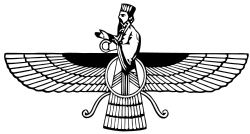
Back اضطهاد الزرداشتيين Arabic Zoroastrierverfolgung German Persecución de los zoroastrianos Spanish آزار زرتشتیان Persian Persécution des zoroastriens French Penindasan Zoroastrianisme ID Persecuzione degli zoroastriani Italian Fermana Zerdeştiyan Kurdish Perseguição aos zoroastristas Portuguese Përndjekja e zoroastrianëve Albanian
This article needs additional citations for verification. (December 2021) |
| Part of a series on |
| Zoroastrianism |
|---|
 |
|
|
| Part of a series on |
| Discrimination |
|---|
 |
| Freedom of religion |
|---|
| Religion portal |
The persecution of Zoroastrians is a significant aspect of the later part of the community's history. It is speculated that religious strife existed between Zoroastrians and early Christians, particularly within the context of the Roman–Persian Wars, though the extent of this phenomenon remains unclear. While it was a widespread religion in West Asia for over a millennium, Zoroastrianism began to decline drastically in the aftermath of the Muslim conquest of Persia. The annexation of the Sasanian Empire by the Rashidun Caliphate marked a monumental shift for the former's Zoroastrian-majority society, which was eventually subsumed by the ensuing process of Islamization. During this period, discrimination and harassment against Zoroastrians typically took place in the form of forced conversions and sparse violence. Early Muslims who arrived in the region are recorded to have destroyed Zoroastrian temples or repurposed them as mosques. Zoroastrian practices gradually became circumscribed under Islamic law, which included the levying of a non-Muslim tax known as jizya.[1]
Early Muslim behaviour with Zoroastrians may have been motivated in part by the fact that they are not explicitly classified as "People of the Book" in the Quran.[1] Although some interpretations do extend this status to the community, the wider consensus among Muslim scholars is that "People of the Book" only identifies the followers of pre-Islamic Abrahamic religions—chiefly Judaism and Christianity—and consequently excludes Zoroastrianism, which is classified as an Iranian religion. Thus, the relative lack of amnesty and privileges for Zoroastrians at this time prompted a large part of the community to flee from Persia to neighbouring India, where they were granted asylum by local kings. The descendants of these Zoroastrian refugees of the early Muslim conquests are known as the Parsi people, who comprise the most prominent community of Indian Zoroastrians today.
Amidst the waves of exoduses, numerous Zoroastrians stayed in Persia and converted to Islam, primarily to integrate and gain full social status under the reign of the caliphates. For approximately 200 years after the collapse of the Sasanian Empire, Persia was ruled by Arab Muslims, but the impact of Arabization was ultimately not as widespread as the rest of West Asia due to the Iranian Intermezzo, which marked the resurgence of both Iranian self-governance and the Persian language, albeit with an Arabized script.[1] Nevertheless, conditions failed to improve for the community, which continued to intermittently experience persecution as a religious minority under successive Muslim dynasties, such as the Safavids and the Qajars.
Beyond India, the global Zoroastrian population is largely concentrated in Iran, the Kurdistan Region of Iraq, and North America. In modern Iran, the religion was held in particularly high esteem under the Pahlavi dynasty, which sought to assert pre-Islamic Iranian nationalism throughout the country. Since the Islamic Revolution in 1979, it remains formally recognized by the Iranian government, which has allocated one seat in the Islamic Consultative Assembly for the Iranian Zoroastrian community.
- ^ a b c Houtsma 1936, p. 100, Volume 2
© MMXXIII Rich X Search. We shall prevail. All rights reserved. Rich X Search